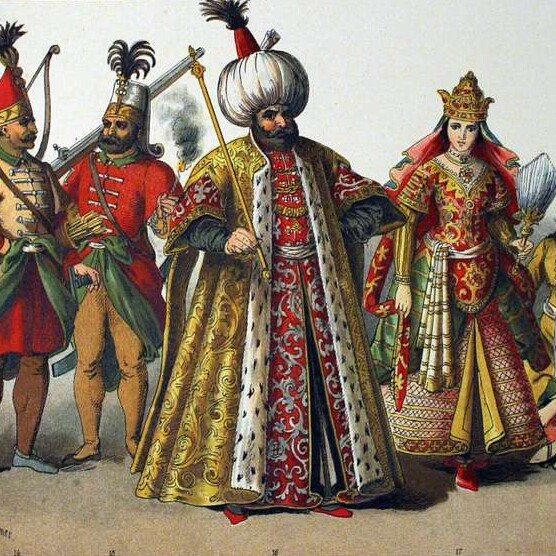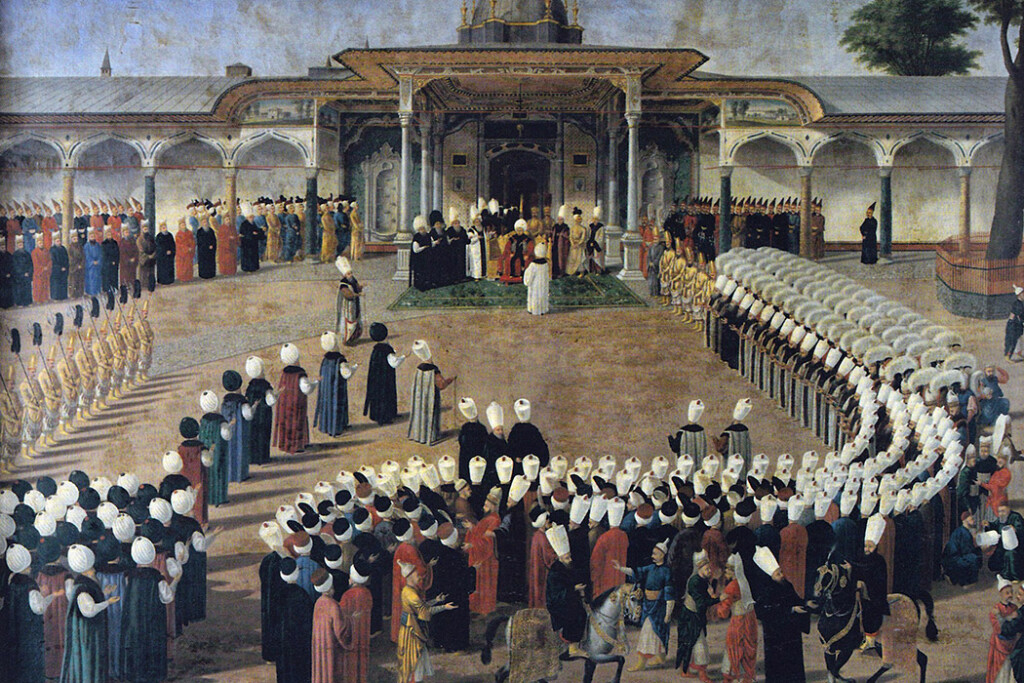Journeying through the history of Arab dress, the next stop is the realm of the Ottoman Empire, an empire that spanned from the late 14th century until the early 20th century. Succeeding the Mamluk Sultanate in 1517, the Ottoman Empire emerged as a dominant political and cultural force, leaving an indelible mark on the Mediterranean and Middle East regions. Renowned for its military prowess, the empire was also a hub of cultural achievements that shaped the region’s history. From the grandeur of the Blue Mosque and Topkapi Palace to the intricacy of its legal systems and the flourishing of arts and literature, the empire’s cultural contributions are prominent. The grandeur and intricacy of the Ottoman Empire’s cultural achievements also extended to the realm of fashion.
A crucial element of this rich history is the distinctive clothing that characterized the Ottoman era. A blend of Turkish and Arab styles, Ottoman clothing was a reflection of the empire’s diverse cultural heritage. This blog post delves into the intricacies of Ottoman fashion, exploring the materials, styles, and regional variations that defined this fascinating period in history. Join us as we unfold the layers of this sartorial legacy, uncovering the stories and significance embedded in the fabric of Ottoman dress.
Material and Style
Ottoman clothing was a lavish display of the empire’s wealth and craftsmanship. The book “Islamic Textiles” by Patricia L. Baker provides a stunning glimpse into the luxurious garments and fabrics that adorned the Ottoman elite. Shimmering metallic and sumptuous silk brocades, each more intricate than the last, were common materials used in the creation of these splendid garments. However, it’s essential to note that not all garments illustrated in “Arab Dress: From the Dawn of Islam to Modern Times” were necessarily presented as honorifics.
Further exploring the sartorial landscape of the Ottoman Empire, the book “Arab Dress: From the Dawn of Islam to Modern Times” by Yedida Kalfon Stillman highlights the blend of Turkish and Arab styles that defined Ottoman clothing. The diversity in women’s clothing was particularly striking, with each region contributing to a rich tapestry of styles and designs. Urban elites often donned the Turkish-style qaftan for men and the yelek, a long, tightly-fitted coat, for women.
Yet, the distinct regional styles that flourished outside of the empire’s principal metropolitan seats of administration must not be overlooked. These styles were defined by not-so-minor differences in decorative details such as embroidery, colour, fabric pattern, fastenings, and trimming. The extent of these variations is vividly captured in the photograph album “Les costumes populaires de la Turquie en 1873” by Hamdy Bey and M. de Launay. These differences, though subtle, tell a story of a diverse empire unified by a shared sartorial elegance.
Headgear
During the Ottoman period, headgear wasn’t just a matter of fashion; it was a symbol of status, rank, and allegiance. “Arab Dress: From the Dawn of Islam to Modern Times” elucidates that while the Ottoman era saw evolutions in many cultural facets, headgear had deep roots that traced back to preceding periods. For the military elite, the standard headgear was a robust cap sporting a distinctive triangular front. This cap, in certain instances, might have been adorned with a metallic plaque and occasionally trimmed with fur, known as the sharbush. In some styles, a small kerchief would be wrapped around the cap, forming a type of turban known as the takhfÊfa. Additionally, the chief eunuchs, who were significant figures in the court hierarchy, wore turbans uniquely wound under the chin, often referred to as taÈnÊk al-im§ma or simply al-Èanak. The headgear worn during the Ottoman period was as diverse as it was meaningful, echoing the empire’s vast expanse and intricate cultural fabric.
Role of dress in court culture
Clothing in the Ottoman Empire, especially at the court, wasn’t just about personal adornment. It was a complex language that communicated rank, allegiance, and distinction. The refined court protocol, with nuances from Persian models, was evident in the sartorial choices of the courtiers. Ceremonial and military attires maintained their Turkish essence, yet certain fashions found their way into the wardrobes of urban elites, such as the qaftan and the yelek. Beyond mere fashion, clothing at the court played pivotal roles in delineating social hierarchies. Different religious and ethnic groups were often required to wear specific colours and styles, turning public appearances into a mosaic of societal classifications. Furthermore, while certain Ottoman attire was adopted by the urban elite, distinct regional styles remained prevalent outside of the main metropolitan areas. The role of dress in court culture was multi-faceted: it was a tool for societal order, a reflection of the empire’s vast diversity, and a testament to the Ottomans’ opulence and grandeur.
Cultural Influence and Geographical Scope
At its pinnacle, the Ottoman Empire was a colossal entity that spanned southeastern Europe, western Asia, and northern Africa. The empire’s vast expanse left an indelible mark on the regions it touched, intricately weaving its cultural threads into the existing fabric of these lands. Istanbul, formerly known as Constantinople, served as a vibrant hub of activity and a testament to the empire’s political, economic, and cultural might.
The conquering of the Arab East in the early 16th century marked a monumental shift, more as a continuation of the preceding cultural era rather than a stark change. This blending of cultures created a decadent mosaic of traditions, styles, and aesthetics. While ceremonial and military dress retained its Turkish roots, the infusion of Arab styles and terminology enriched the diverse array of fashion during that period. The intersection of Ottoman and Arab aesthetics gave rise to a unique blend that was evident in the garments and textiles of the time.
It is crucial to note that despite these overarching influences, regional styles remained prevalent. These styles were marked by distinct differences in cut, embroidery, colour, fabric patterns, and trimmings. The resulting fashion landscape reflected the diverse cultures under the Ottoman umbrella, each contributing to the cultural richness of the empire. This amalgamation of diverse cultures, traditions, and styles has left a lasting legacy on the regions once under its rule, profoundly shaping their cultural and historical landscape.
Documentation and Sources
Ottoman dress is well-documented through a variety of sources, including written accounts, visual representations, and surviving garments and textiles. Written sources such as travelogues, chronicles, and legal texts provide detailed descriptions of the clothing and accessories worn during the Ottoman period, offering insights into the materials, production methods, and cultural significance of different garments.
Visual sources, including paintings, miniatures, and photographs, capture the essence of Ottoman dress, showcasing the luxurious fabrics, intricate embroidery, and distinctive head coverings and accessories that defined the era.
Surviving garments and textiles, such as kaftans, robes, and head coverings, serve as tangible evidence of the materials, techniques, and designs used in Ottoman dress. These items, often housed in museums and private collections, are invaluable for researchers and fashion enthusiasts alike. However, the study of Ottoman dress is complicated by its constant evolution in response to shifting political, social, and cultural trends, as well as the vast geographical and cultural scope of the Empire, which resulted in countless regional variations and styles.
The Ottoman Empire was a vast and diverse cultural landscape that spanned centuries and continents. The unique blend of Turkish, Arab, and Persian influences, along with the empire’s continuous adaptation to evolving political, social, and cultural trends, created a rich and varied landscape of fashion that was both luxurious and full of symbolism. From the use of sumptuous fabrics like silk, velvet, and brocade to the intricate embroidery and distinctive head coverings that defined Ottoman style, clothing was an integral part of the empire’s identity and a reflection of its complex social and cultural hierarchies. The legacy of Ottoman dress lives on today, influencing modern fashion and serving as a testament to the empire’s enduring impact on the world of style and design.


